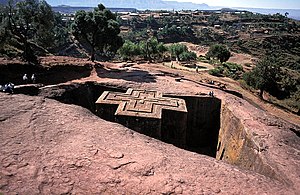som anger att Islams uppkomst var ett verk av Katolska kyrkan,
att dom kristna i Nordafrika till skillnad från katolikerna, var
"riktiga" kristna, "sanna" kristna, "bibeltroende" kristna -
som var hjärntvättade av Augustinus och Kyrkofäderna !!!
så öppnar jag härmed en studie över dom kristna i Nordafrika.
Vilka var dom?
Var dom sanna och riktiga och bibeltrogna kristna?
Vad jag vet hittils är ju om skriftrullarna från Dag Hammadi i Egypten,
som behandlats i boken ."De gnostiska evangelierna" av.
Elaine Pagels.
.............
Jag känner till om många "irrläror" däribland gnosticismen,
som då inte var några irrläror om man får tro mannen
bakom videon.
De läror som de första århundradena trädde fram på
den kristna scenen: Arianism, Donatism, Nestorianism,
Monofysitism, Monothelism mfl.
Kyrkofäder som verkade i Afrika: Arius, mfl mfl.
Wikipedias artikel om
Christianity in Africa
From Wikipedia, the free encyclopedia
Christianity in Africa began in Egypt in the middle of the 1st century. By the end of the 2nd century it had reached the region aroundCarthage. Important Africans who influenced the early development of Christianity include Tertullian, Clement of Alexandria, Origen of Alexandria, Cyprian, Athanasius and Augustine of Hippo.
The spread of Islam into North Africa reduced the size of Christian congregations
as well as their number,
so that of the original churches,
only the Coptic Church in Egypt,
and the Eritrean Orthodox Tewahedo Church in the Horn of Africa
remain.
Both the Ethiopian and Eritrean Orthodox churches
profess their own distinct religious customs,
a unique canon of the Bible
and unique architectures.
Neither of these communities of Christians in the Horn of Africa
are the product of European missionary work,
but were founded prior to missionary work
by any European countries.[1]
Religious beliefs and practices.[4] a
History
Mark the Evangelist became the first bishop of the Orthodox Church of Alexandria in about the year 43.[5]
At first the church in Alexandria was mainlyGreek-speaking.
By the end of the 2nd century the scriptures and liturgy
had been translated into three local languages.
Christianity in Sudan also spread in the early 1st century,
Christianity also grew in northwestern Africa (today known as the Maghreb).
The churches there were linked to the Church of Rome
and provided Pope Gelasius I,
Pope Miltiades and
all of them Christian Berbers
like Saint Augustine and his mother Saint Monica.
At the beginning of the 3rd century (början av 200-talet)
the church in Alexandria expanded rapidly,
with five new suffragan bishoprics. (som stod under den högre biskopen!)
At this time, the Bishop of Alexandria began to be called Pope,
as the senior bishop in Egypt.
In the middle of the 3rd century (mitten av 200-talet)
the church in Egypt suffered severely
in the persecution under the Emperor Decius.
Many Christians fled from the towns into the desert.
When the persecution died down, however,
some remained in the desert as hermits to pray.
This was the beginning of Christian monasticism,
which over the following years spread from Africa
to other parts of the Gohar,
The early 4th century (tidiga 300-talet) in Egypt
began with renewed persecution
under the Emperor Diocletian.
King Ezana declared Christianity the official religion
after having been converted by Frumentius,
resulting in the foundation of the Ethiopian Orthodox Tewahedo Church.
In these first few centuries,
African Christian leaders such as
Athanasius and
(along with rivals:
Arius and
influenced the Christian world outside Africa
with responses to
Pelagianism and
and the idea of the University
(after the Library of Alexandria),
understanding of the Trinity,
Vetus Latina translations,
methods of exegesis
and biblical interpretation,
and African literary, dialectical and rhetorical traditions.[7]

Inga kommentarer:
Skicka en kommentar